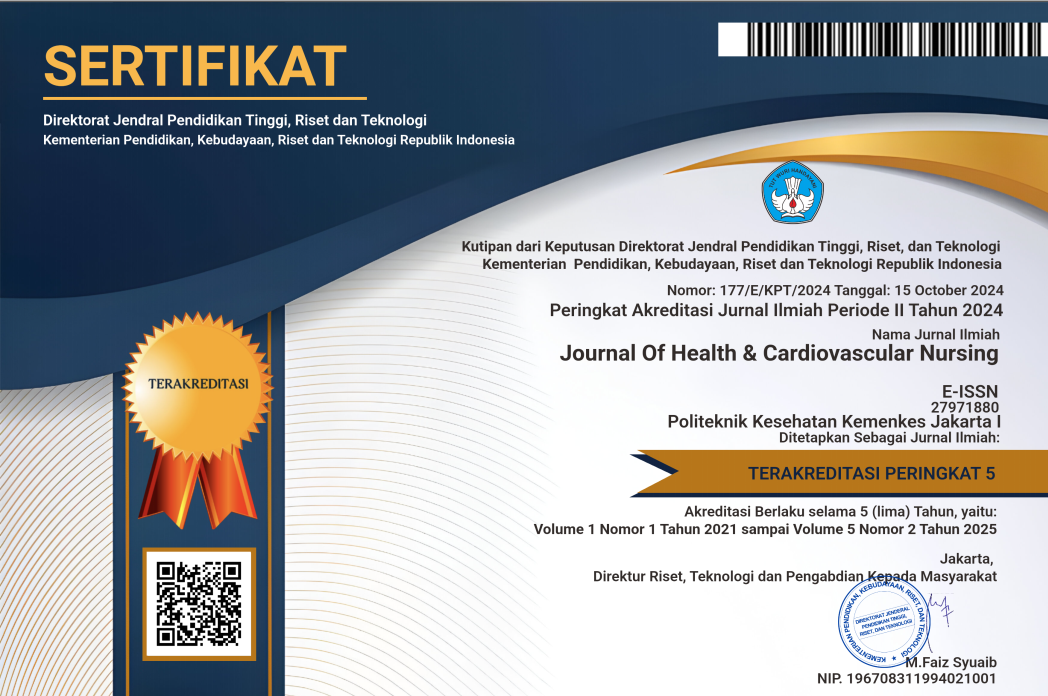The Effect of Fall Prevention Education on the Risk of Falls in the Elderly
Pengaruh Edukasi Pencegahan Jatuh Terhadap Risiko Jatuh Pada Lanjut Usia
Keywords:
lanjut usia, pendidikan kesehatan, risiko jatuhAbstract
A fall in the elderly causes a person to suddenly lie down accidentally on the ground or floor or lower level. This condition is often experienced by 1 in 3 elderly people every year. Risk factors for falls in the elderly are behaviour, biological, environmental, and socio-economic. Nurses can make efforts to reduce the risk of falls in the elderly through education for the elderly and their families. The study aimed to determine the extent of the influence of fall prevention educational interventions on the risk of falls in the elderly in the family context. This study used a quasi-experiment, a group pretest post-test, education was carried out using a fall prevention booklet for the elderly in the intervention group and without a booklet in the control group. This research used a purposive sampling method using inclusion criteria to obtain 60 respondents consisting of 30 respondents in the intervention group and 30 respondents in the control group with 6 interactions carried out. The results of this study using the Wilcoxon test from fall prevention education in the intervention group and control group showed a decrease or reduction in fall risk scores (negative rank) in 15 respondents in the intervention group with an average decrease of 8. In the control group, there were 5 respondents experienced a decrease fall risk score, where the average value decreases by 3. The results of this test show the influence of fall prevention education in the elderly on the risk of falls with a p-value <0.001. The conclusion is that educational interventions to prevent falls in the elderly have an impact on reducing risk factors for falls in the elderly. The suggestion is that health education about fall prevention should be given to elderly clients as individuals and groups so that it will reduce risk factors for falls.Downloads
References
Allali, G., Ayers, E. I., Holtzer, R., & Verghese, J. (2017). The role of postural instability/gait difficulty and fear of falling in predicting falls in non-demented older adults. Archives of Gerontology and Geriatrics, 69, 15–20. https://doi.org/10.1016/j.archger.2016.09.008
Asniar, Kamil, H., & Mayasari, P. (2020). Pendidikan dan Promosi Kesehatan. Syiah Kuala University.
Barnett, A., Smith, B., Lord, S. R., Williams, M., & Baumand, A. (2003). Community-based group exercise improves balance and reduces falls in at-risk older people: A randomised controlled trial. Age and Ageing, 32(4), 407–414. https://doi.org/10.1093/ageing/32.4.407
BNPB. (2021). Community / Public Health Nursing?: Promoting the Health of Populations 5th Edition Chapter 5 Epidemiology. INews.Id.
Brauer, S. (2011). Falls prevention. Journal of Physiotherapy, 57(2), 130. https://doi.org/10.1016/S1836-9553(11)70028-5
Chang, M., Huang, Y. H., & Jung, H. (2011). The effectiveness of the exercise education programme on fall prevention of the community-dwelling elderly: A preliminary study. Hong Kong Journal of Occupational Therapy, 21(2), 56–63. https://doi.org/10.1016/j.hkjot.2011.10.002
Chidume, T. (2021). Promoting older adult fall prevention education and awareness in a community setting: A nurse-led intervention. Applied Nursing Research, 57(November 2020), 151392. https://doi.org/10.1016/j.apnr.2020.151392
Clemson, L., Cumming, R. G., Kendig, H., Swann, M., Heard, R., & Taylor, K. (2004). The effectiveness of a community-based program for reducing the incidence of falls in the elderly: A randomized trial. Journal of the American Geriatrics Society, 52(9), 1487–1494. https://doi.org/10.1111/j.1532-5415.2004.52411.x
Clemson, L., Stark, S., Pighills, A. C., Torgerson, D. J., Sherrington, C., & Lamb, S. E. (2019). Environmental interventions for preventing falls in older people living in the community. Cochrane Database of Systematic Reviews, 2019(2). https://doi.org/10.1002/14651858.CD013258
Delbaere, K., Close, J. C. T., Brodaty, H., Sachdev, P., & Lord, S. R. (2010). Determinants of disparities between perceived and physiological risk of falling among elderly people: Cohort study. BMJ (Online), 341(7770). https://doi.org/10.1136/bmj
Drootin, M. (2011). Summary of the updated american geriatrics society/british geriatrics society clinical practice guideline for prevention of falls in older persons. Journal of the American Geriatrics Society, 59(1), 148–157. https://doi.org/10.1111/j.1532-5415.2010.03234.x
Ellmers, T. J., Wilson, M. R., Norris, M., & Young, W. R. (2022). Protective or harmful? A qualitative exploration of older people’s perceptions of worries about falling. Age and Ageing, 51(4), 1–10. https://doi.org/10.1093/ageing/afac067
Falls, P. (2009). Guidebook for Preventing Falls and Harm From Falls in Older People?: Australian Residential Aged Care Facilities.
Francis-Coad, J., Farlie, M. K., Haines, T., Black, L., Weselman, T., Cummings, P., & Hill, A. M. (2023). Revising and evaluating falls prevention education for older adults in hospital. Health Education Journal, 82(8), 878–891. https://doi.org/10.1177/00178969231204329
Grealish, L., Real, B., Todd, J. A., Darch, J., Soltau, D., Phelan, M., Lunn, M., Brandis, S., Cooke, M., & Chaboyer, W. (2019). Implementing Evidence-Based Guidelines for Falls Prevention: Observations of Nursing Activities During the Care of Older People With Cognitive Impairment. Worldviews on Evidence-Based Nursing, 16(5), 335–343. https://doi.org/10.1111/wvn.12376
Kalache, Alexandre. Ku, D., Kannus, P., Palvanen, M., Niemi, S., Parkkari, J., Jaglal, S. B., Haroun, V. a, Salbach, N. M., Hawker, G., Voth, J., Lou, W., Kontos, P., Cameron, J. E., Cockerill, R., Bereket, T., Hale, S., Neaman, R., Lee, P., Talbot, E., … Chambers, R. (2007). There’s no place like phone Global Mobile Consumer Survey 2016: UK Cut. World Health Organisation, 5(3), 475–487. http://psycnet.apa.org/psycinfo/2003-02630-007%5Cnhttp://www.ncbi.nlm.nih.gov/pubmed/10960937%5Cnhttp://www.ncbi.nlm.nih.gov/pubmed/1991946%5Cnhttp://www.ncbi.nlm.nih.gov/pmc/articles/PMC2769032/%5Cnhttp://www.nice.org.uk/guidance/ph6/resources/behaviour-
Laing, S. S., Silver, I. F., York, S., & Phelan, E. A. (2011). Fall prevention knowledge, attitude, and practices of community stakeholders and older adults. Journal of Aging Research, 2011(2). https://doi.org/10.4061/2011/395357
Luong, L. T. (2008). Good Practice Guide Prevention of falls in the elderly living at home. Institut national de prévention et d’éducation pour la santé.
Manoj, S. (2012). Theoretical of Fundation of health education and health promotion.
Martin, B., & Nahar, V. K. (2017). Book Review: Theoretical Foundations of Health Education and Health Promotion. In Perspectives in Public Health (Vol. 137, Issue 6). https://doi.org/10.1177/1757913917722747
Moncada, L. V. V., & Mire, L. G. (2017). Preventing Falls in Older Persons. American Family Physician, 96(4), 240–247.
Nies, M., & McEwen, M. (2016). Community/Public Health Nursing (6th Editio). Saunders.
Reznik, D. (2013). Fall prevention. American Journal of Nursing, 113(7), 12. https://doi.org/10.1097/01.NAJ.0000431897.51118.69
Scheffer, A. C., Schuurmans, M. J., Van dijk, N., Van der hooft, T., & De rooij, S. E. (2008). Fear of falling: Measurement strategy, prevalence, risk factors and consequences among older persons. Age and Ageing, 37(1), 19–24. https://doi.org/10.1093/ageing/afm169
Skalska, A., Wizner, B., Piotrowicz, K., Klich-Raczka, A., Klimek, E., Mossakowska, M., Rowi?ski, R., Kozak-Szkopek, E., Jó?wiak, A., Gasowski, J., & Grodzicki, T. (2013). The prevalence of falls and their relation to visual and hearing impairments among a nation-wide cohort of older Poles. Experimental Gerontology, 48(2), 140–146. https://doi.org/10.1016/j.exger.2012.12.003
Soh, S. L. H., Lane, J., Xu, T., Gleeson, N., & Tan, C. W. (2021). Falls efficacy instruments for community-dwelling older adults: a COSMIN-based systematic review. BMC Geriatrics, 21(1), 1–10. https://doi.org/10.1186/s12877-020-01960-7
Strupeit, S., Buss, A., & Dassen, T. (2016). Effectiveness of nurse-delivered patient education interventions on quality of life in elders in the hospital: A systematic review. Applied Nursing Research, 32, 217–221. https://doi.org/10.1016/j.apnr.2016.08.004
Tang, H. T., Vu, H. M., Tang, H. T., Tran, P. T., Van Tran, L., Nguyen, C. D., Nguyen, T. Q., Nguyen, C. M. T., Tran, K. Q., & Luong, H. X. (2023). Knowledge, attitude and practice on fall risk factors and prevention among rural older community-dwellers in Vietnam. PLoS ONE, 18(11 November), 1–13. https://doi.org/10.1371/journal.pone.0295119
Uy, Y., Sy, T., Jf, Y., & Wy, C. (2016). original article Prevalence of falls among community-dwelling elderly and its associated factors?: A cross-sectional study in Perak , Malaysia. 11(1), 7–14.
Vieira, E. R., Palmer, R. C., & Chaves, P. H. M. (2016). Prevention of falls in older people living in the community. BMJ (Online), 353. https://doi.org/10.1136/bmj.i1419
Welmer, A. K., Frisendahl, N., Beridze, G., Trevisan, C., & Calderón-Larrañaga, A. (2023). Association Between Concerns About Falling and Risk of Injurious Falls in Older Adults: The Role of Balance Impairment. Journal of the American Medical Directors Association. https://doi.org/10.1016/j.jamda.2023.07.015
Wold, G. H. (2013). Basic Geriatric Nursing. Elsevier Health Sciences.
World Health Organization. (2007). WHO Global Report on Falls Prevention in Older Age. https://doi.org/978 92 4 156353 6
Published
Issue
Section
Copyright (c) 2024 Journal of Health and Cardiovascular Nursing

This work is licensed under a Creative Commons Attribution-ShareAlike 4.0 International License.









